What Do Koalas Eat? – Lesson for Kids
Sara is a recently graduated PhD in Education with interdisciplinary experience in K-12 education.
Christianlly has taught college Physics, Natural science, Earth science, and facilitated laboratory courses. He has a master’s degree in Physics and is currently pursuing his doctorate degree.
Koalas are adorable marsupials that live in the trees of Australia. Explore the characteristics of marsupials to discover what they eat, their herbivorous diets, and the adaptations that help them survive. Updated: 01/18/2022
What Do Koalas Eat?
What is dark green, gummy, and delicious in a koala’s tummy? It’s the leaf from the eucalyptus tree, and it makes up the majority of the koala’s diet.
Koalas are marsupials that live in the forests of eastern Australia. In fact, the trees that they live in are the same trees that they really like to eat. Let’s learn some more about the koala’s food choices by exploring these eucalyptus trees.
What Is a Eucalyptus Tree?
Eucalyptus trees grow in tropical and temperate environments in the southern hemisphere. Most eucalyptus trees can be found in Australia. There are many varieties of eucalyptus, even just on the Australian continent. Koalas in different parts of Australia prefer to eat different eucalyptus species, just like humans in different parts of the world prefer to eat different types of fruits and veggies.
Specifically, koalas eat the leaves of the eucalyptus tree. They can eat up to 14 ounces of leaves per day – almost one pound. Though that might not sound like a lot, remember a koala only weighs about 25 pounds. That’s like a 70-pound kid eating nearly three pounds of salad!
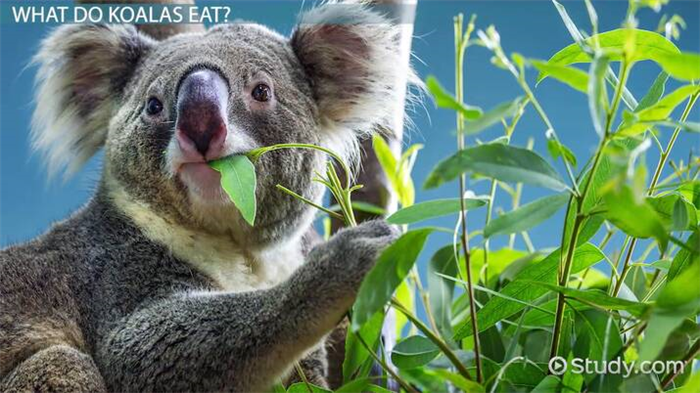
An error occurred trying to load this video.
Try refreshing the page, or contact customer support.
You must c C reate an account to continue watching
Register to view this lesson
As a member, you’ll also get unlimited access to over 84,000 lessons in math, English, science, history, and more. Plus, get practice tests, quizzes, and personalized coaching to help you succeed.
Get unlimited access to over 84,000 lessons.
Already registered? Log in here for access
Resources created by teachers for teachers
I would definitely recommend Study.com to my colleagues. It’s like a teacher waved a magic wand and did the work for me. I feel like it’s a lifeline.
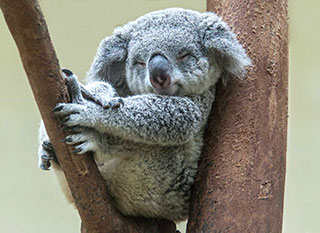
You’re on a roll. Keep up the good work!
Just checking in. Are you still watching?
- 0:04 What Do Koalas Eat?
- 1:12 Eucalyptus, a Koala Treat
- 2:45 Lesson Summary
Want to watch this again later?
Log in or sign up to add this lesson to a Custom Course.
Eucalyptus, a Koala Treat
Eucalyptus leaves are very oily, and this oil actually makes them poisonous to most animals. Eucalyptus leaves are also very fibrous, which makes them tough to chew and difficult to digest. Koalas have special adaptations, or body parts that help them to successfully eat this tricky food.
First, koalas have teeth that work really well to cut and chew eucalyptus leaves. Their sharp front teeth pull the leaves from the tree, and their flat molar teeth grind the eucalyptus leaves down to make sure the koala gets all of the water and nutrition that the leaf holds.
Second, koalas have a special part of their digestive system called a caecum (pronounced see-kum) that’s attached to their intestines. A koala’s caecum contains microorganisms that help to further break down the tough and oily eucalyptus leaves.
In addition to eucalyptus leaves being difficult to eat, they also do not provide a lot of nutrition or calories to the koala. This is why koalas nap up to 20 hours a day. By sleeping, they conserve energy, which means they require less food. While it sleeps, the koala’s energy can be directed towards digestion.
Do Koalas Eat or Drink Anything Else?
Though they prefer to eat eucalyptus, these herbivores (animals that eat only plants) do eat other plants as well. Koalas get almost all of the water that they need from the food that they eat. When the water from plants is not enough, koalas find additional water in tree hollows or from sources on the ground.
Lesson Summary
Koalas are herbivores, plant eaters, who eat almost exclusively eucalyptus leaves. These leaves are tough and poisonous to most animals, but koalas have special adaptations, body parts or abilities that allow them to live in an environment, like the caecum, that make it possible for them to safely eat and digest eucalyptus. Koalas get most of the water they need from the food they eat.
To unlock this lesson you must be a Study.com Member.
Create your account
What Do Koalas Eat?
Koalas are arboreal marsupials native to southern and eastern Australia. Despite its common name, the koala bear is not a bear at all, and its closest living relative is the wombat. The sole member of the family Phascolarctidae, the average koala measures 24 to 33 inches long and weighs from 9 to 33 pounds. Known for their distinctive round head and fluffy greyish-brown fur, koalas have become a symbol of conservation in Australia. While they have few natural predators, the IUCN lists the species as Vulnerable due to habitat loss. Today, conservation efforts are in place that aim to stabilize and increase the number of koalas. Part of the problem is that koalas eat a very specific, low-nutrition diet. This makes conservation more difficult, as it means that only certain habitats are suitable to sustain koala populations. We must therefore ask the question, “what do koalas eat?”
In this article, we’ll make an effort to fully flesh out the diet of koalas. We’ll begin by talking about what koalas like to eat. Next, we’ll discuss how koalas go about foraging for food. Then, we’ll compare what they eat in the wild versus what they eat in captivity. Finally, we’ll end with a conversation about what baby koalas eat. So, without further ado, let’s answer the question, “what do koalas eat?”
What Do Koalas Like to Eat?
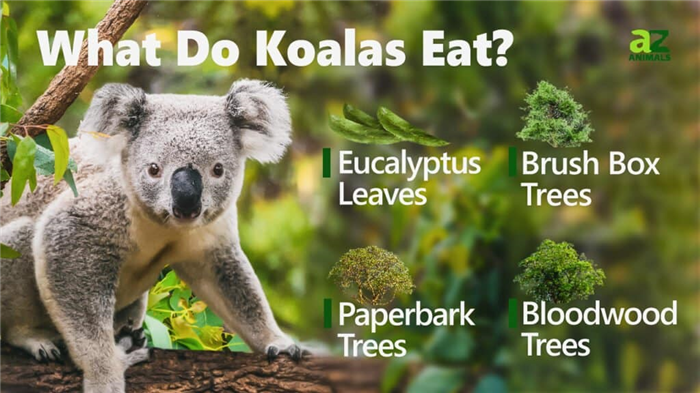
Koalas mostly eat eucalyptus leaves, but also eat the leaves of brush box, paperback, and bloodwood trees.
Koalas are arboreal herbivores, meaning that they spend most of their lives in trees and eat plant matter. To be precise, the bulk of a koala’s diet consists of a single food, the leaves of the eucalyptus tree. There exist over 600 species of eucalyptus, but koalas tend to show a strong preference for the leaves of certain trees. Additionally, as different eucalyptus trees grow in different regions, the diet of a koala in one place will differ from that of a koala in another region. That said, koalas will spend time in other trees and eat the foliage of other tree species. For example, some other trees that koalas forage on include brush box, paperbark, and bloodwood trees. Still, eucalyptus leaves are by far the most important part of a koala’s diet. Similar to how the giant panda relies mostly on bamboo, koala populations could not survive with eucalyptus.
How Do Koalas Forage For Food?
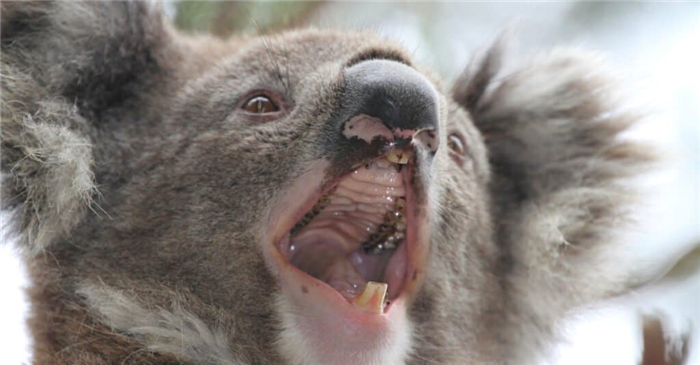
Although koalas possess poor eyesight, they are equipped with
Koalas have adapted specific senses to help them find food while foraging in trees. Namely, koalas mostly rely on their sense of smell to help them find trees that they like to eat. Their keen nose helps them to determine which eucalyptus trees they like, and which to avoid. On the other hand, koalas possess poor vision, and so only marginally rely on their eyesight to find food. Additionally, while they have amazing hearing, their hearing is not so useful in locating their next meal. Rather, their hearing is useful for detecting predators and communicating with other koalas. Koalas also have a sensitive sense of touch, as they use their hands to navigate trees and handle food. Finally, koalas also have a unique sense of taste, as they evolved more bitter taste receptors than other marsupials. This likely allows them to detect toxic substances in eucalyptus leaves.
Given that eucalyptus leaves possess poor nutritional content, koalas spend a large part of their day sleeping. On average, a koala will sleep between 18 and 22 hours each day to save energy. Additionally, eucalyptus leaves are poisonous to most animals, but koalas have evolved to process the toxins in the leaves. That said, even koalas will avoid the leaves of certain trees that possess high levels of toxins. Koalas evolved an organ known as a caecum, which is full of bacteria that help to break down the fiber in eucalyptus leaves. On average, a koala will eat between 1 to 1.5 pounds of leaves per day. Koalas use their sharp incisors to rip the leaves, and then their molars to cut and shear them. They feed by holding onto a branch with their back paws while feeding with their front paws.
What Do Koalas Eat in the Wild?
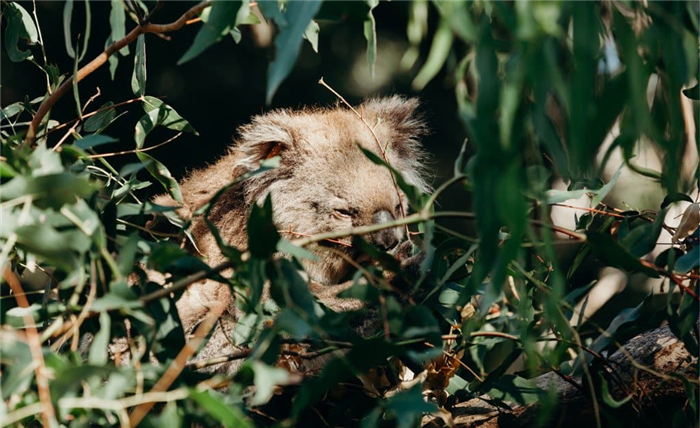
Koalas can eat between 1 to 1.5 pounds of leaves per day.
In the wild, koalas spend the majority of their day eating and sleeping, particularly sleeping. Although they sleep on average 20 hours per day, koalas still manage to feed between 5 to 6 times per day. This is necessary, given the low nutritional content of their diet, which is almost exclusively made up of eucalyptus leaves. Additionally, although there are more than 600 types of eucalyptus trees, koalas strongly prefer a few over most of the others. Research suggests this has to do with lower toxins and fiber content and higher protein content in the leaves of these trees. While the majority of their diet consists of eucalyptus leaves, koalas also occasionally dine on the leaves of other trees. Some of their other favorites include the leaves of brush box trees, paperbark trees, and bloodwood trees. They appear to frequently enjoy eating these leaves on hotter, drier days.
What Do Captive Koalas Eat?
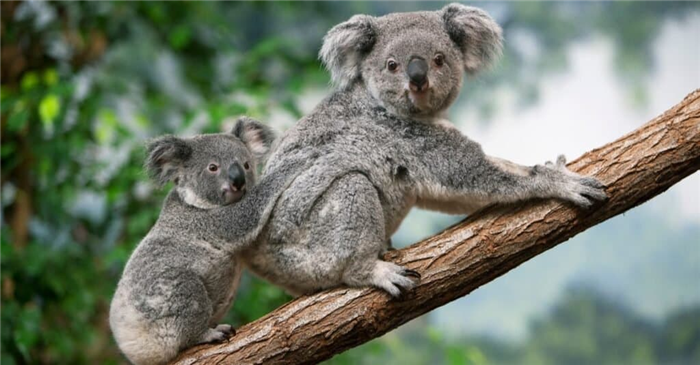
Koalas are fed a variety of leaves each day because they are notoriously picky eaters.
Due to their cute appearance, koalas are common in both the exotic pet trade and in zoos around the world. Despite their cuddly look, koalas don’t make great pets and require a lot of specialized care. This care starts with their diet, which is very specific. In captivity, koalas are often fed branches from several different types of eucalyptus tree each day. This ensures that they get plenty of variety in their diet. Also, because koalas are notoriously picky, it makes it more likely that they will get enough nutrition. Upon being presented with a selection of branches, a koala will then set about choosing its favorite leaves. Somehow, koalas always seem to know which plants to avoid ingesting too many toxins. A captive koala can eat between 1 to 1.5 pounds of leaves in a single day
What Do Baby Koalas Eat?
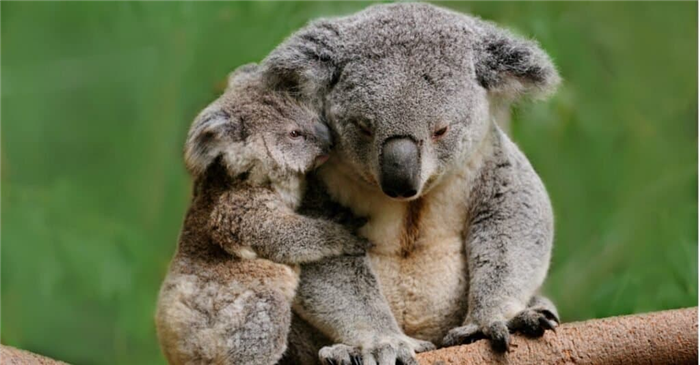
Baby koalas are known as joeys and live in their mother’s pouch for the first six months of their life.
Like other marsupials, koalas give birth to underdeveloped young. After a 33 to 35 day gestation period, a female koala will give birth to a sole joey, or baby koala. The average joey weighs around 0.02 ounces, and is completely reliant on its mother. Upon birth, the joey will then crawl into its mother’s pouch, where it will remain for the first 6 or 7 months of its life. Inside the pouch, the joey lives off of its mother’s milk. However, female koalas produce relatively very little milk. To compensate, the joey will drink its mother’s milk for the first year of its life. At around 6 months old, the female koala will begin to prepare her offspring for a eucalyptus-based diet. To accomplish this, the female will eat leaves, predigest them, and then produce a fecal pap to feed to her joey.
What Do Koalas Eat?
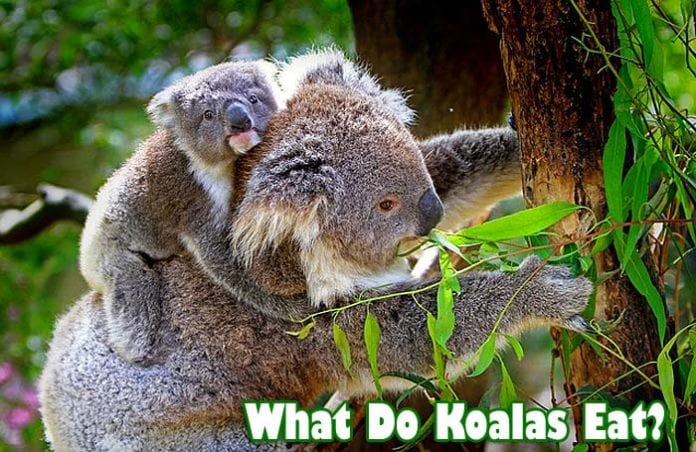
What Do Koalas Eat? Koalas are iconic marsupials spotting black oval noses and round ears. They are native to Australia where they are only found worldwide. Koalas spend most of their time sleeping and waking time eating.
These Australia’s iconic symbols are herbivores. Their primary diet constitutes mainly of the eucalyptus leaves and occasionally leaves from related tree species.
Table of Contents
What Do Koalas Eat?
| Kingdom | Order | Family | Genus | Species |
|---|---|---|---|---|
| Animalia | Diprotodontia | Phascolarctidae | Phascolarctos | Phascolarctos cinereus |
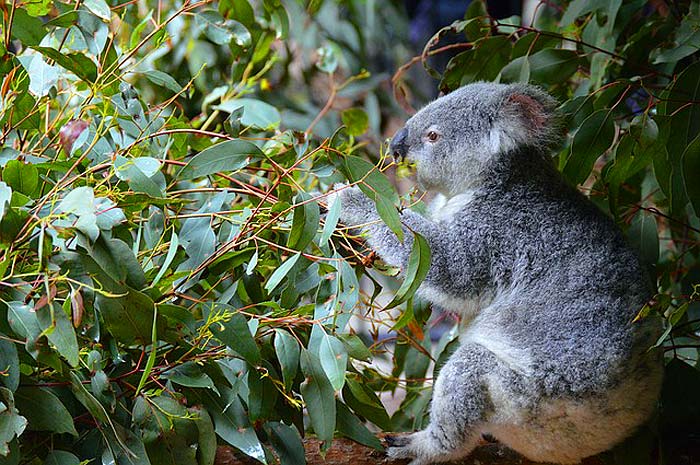
Koalas (Phascolarctos cinereus) are herbivores feeding on leaves from eucalypt and non-eucalypt tree species.
Interestingly, a majority of the diet of the koalas comes from a few of the eucalyptus tree species with the examples of the following: Eucalyptus viminalis, Eucalyptus punctata, Eucalyptus ovata, Eucalyptus camaldulensis, and Eucalyptus tereticornis.
- Eucalyptus leaves are very toxic, especially to animals but koalas have a specialized mechanism to go around this toxicity.
- Koalas have bacterial flora in their stomachs, which comes in handy to metabolize the toxins from eucalyptus leaves.
- There is only 1 Koala species that exists, Phascolarctos cinereus. However, there appear to be differences in the opinions from the scientific community as to whether 3 subspecies of Koalas exist or if these subspecies can only be viewed as races.
- The koala’s fur varies from light grey to brown depending on their geographical location. Koalas living in the south of Australia tend to have a thick and dark coat, which is at times browner.
- Brown koalas are mostly found in South Australia, and Victoria states. Those living in north Australia spot a light grey hue and are mostly found in Queensland state. They tend to be smaller compared to their southern counterparts.
- Koalas living in Australia’s New South Wales state has a grey-brown color.
Koalas are arboreal meaning they will tend to inhabit forested areas, especially those with eucalyptus trees.
They will only come to land when they need to like looking for a new place to live, or when they are in search of water or safety. Aside from this, koalas will spend most of their lives on trees.
How Do Koalas Hunt?
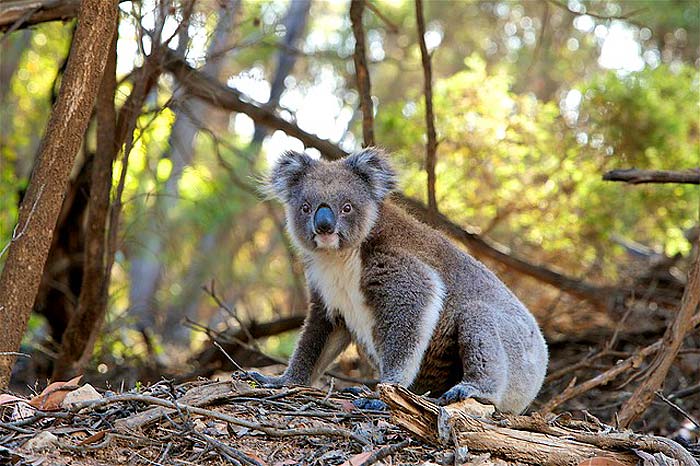
Koalas strictly feed on a plant diet, and they will not prey on other organisms. As a result, koalas do not hunt.
When Do Koalas Eat?
Koalas are nocturnal feeders. This means that they come out at night to feed and then go back to their usual sleeping pattern. Koalas have been noted to eat during the first half of the night.
How Often Do Koalas Eat?
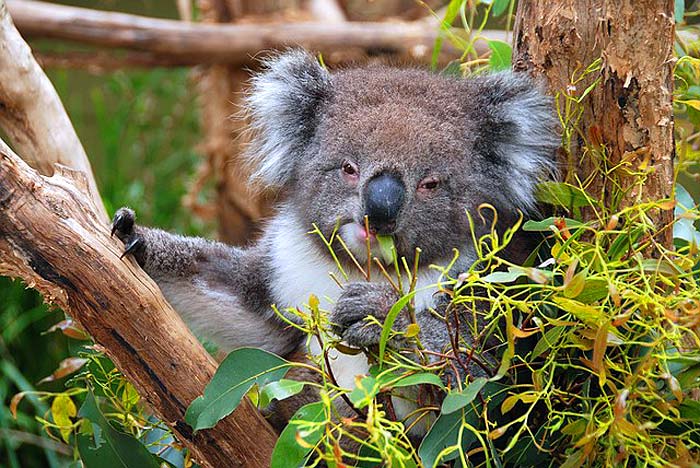
Koalas do not feed continuously during their feeding sessions. They feed in a series of about 6 to 10 bouts for an average of 20 minutes but can last for between 5 and 18 minutes.
- Adult koalas feed as much as they can to reach their daily schedule of consuming between 200-500 grams of eucalyptus leaves. They cannot eat more than three pounds of leaves each day, or they would experience indigestion.
- Given the above, it is worth to note that Koalas will spend most of their wake time feeding, but as they do so, they cannot exceed their daily limit of food intake.
- Interestingly, how often koalas feed depends on the weather. In Australia’s south, where it is colder (wet and cold during winter) compared to the north, koalas do not eat during heavy rains.
These marsupials remained curled up into a ball during this time. They do this to insulate themselves from the cold and to conserve energy.
What Eats Koalas?
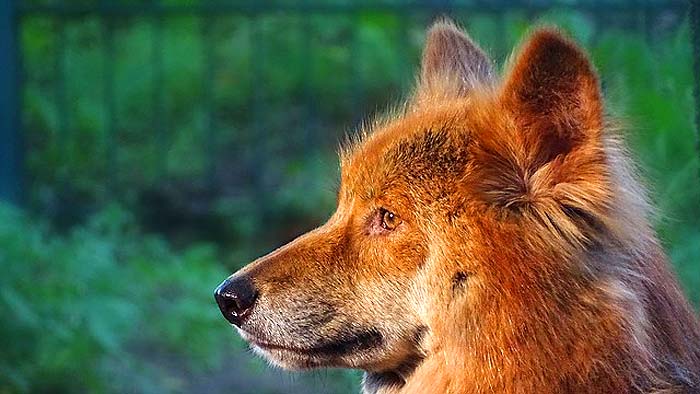
Koalas have very few natural enemies, and because of this, they are at the apex of their food chain in Australia’s mainland. Some of their predators may include large owls and dingoes. Pythons and eagles also predate on koalas.
Koala facts
Genus: Phascolarcto – phaskolos meaning pouched; arktos meaning bear (derived from Greek).
Species: cinereus meaning ashy-grey (derived from Latin).
Etymology
The word koala is said to come from the Dharug peoples (whose traditional lands span the area from Parramatta to the Blue Mountains of New South Wales) word meaning ‘no water’. In South East Queensland, koalas are called dumbirrbi in the Jagera language, marrambi in the Yugarabul language, borobi in the Ugambeh language, and dumbribbi in the Turrbul language.
Koalas are a type of mammal called marsupials, which give birth to underdeveloped young. They are so different from any other marsupial, however, that they have been classified into their own family, called Phascolarctidae. They share a number of characteristics with wombats, who are their closest living relatives, including a backward-facing pouch.
Conservation status
In February 2022 the status of the koala has recently been changed from vulnerable to endangered. The change in status means an increased level of protection for koalas in Queensland, New South Wales and the Australian Capital Territory.
Estimated distribution of koalas in Queensland
Koalas may also live in urban areas
Habitat and distribution
Koalas live over a range of open forest and woodland communities but ultimately their habitat is defined by the presence of a select group of food trees. Koalas are found in higher densities where food trees are growing on more fertile soils and along watercourses. They do, however, remain in areas where their habitat has been partially cleared and in urban areas.
The distribution of koalas covers much of Queensland, New South Wales, Victoria and a small area in South Australia. Over the past 200 years, their distribution does not appear to have reduced, however, individual koala populations have declined. Local extinctions have occurred due to clearing and fragmentation of eucalypt woodlands and forests for agriculture and human settlement. Fossil records indicate that many years ago, the koala inhabited parts of Western Australia and the Northern Territory. There are no fossil records of koalas ever living in Tasmania.
In Queensland, the greatest concentration of koalas is in South East Queensland where they now compete for space with a rapidly growing human population.
Description
Koalas are well-known for their large round head, big furry ears and big black nose. Their fur is usually grey-brown in colour with white fur on the chest, inner arms, ears and bottom. They have no fur on their nose or the palms of their paws. Koalas have particularly hard bottoms, which is similar to their closest relative, the wombat. For the koala, this feature enables them to wedge comfortably in tree forks for long periods of time, whereas the wombat uses its hard bottom as a defence mechanism.
Koalas have poor vision and rely heavily on their other senses. They have excellent hearing which helps them detect predators and other koalas. They have an acute sense of smell which also helps them detect other koalas and their favourite food trees. The male uses a scent gland on his chest to mark trees and attract females, by rubbing his chest up and down the trunk. The gland oozes a clear, oily, strong musky smelling liquid.
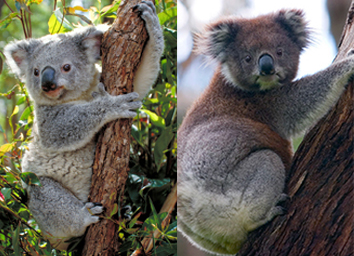
Northern koala (left) and Southern koala (right)
A matter of size
The size, colour and shape of koalas differs slightly across eastern Australia. Koalas in Queensland are smaller, lighter in colour and have less fur than those in New South Wales, Victoria and South Australia. Queensland’s adult female koalas on average weigh between 5 and 6kg and adult males weigh between 6 and 8kg, compared to Victoria’s adult female koalas with an average weight of 8.5kg and adult males 12kg.
Koala claws are good for climbing
Koala scratches on a Grey gum (Eucalyptus major)
Claws for climbing
Koalas have strong arms, powerful legs and sharp claws suitable for climbing trees. Koalas are arboreal (tree dwelling) mammals, however, they do climb down to the ground to move between trees. When koalas are on the ground, they walk slowly as they are poorly adapted to walking on the ground, however when disturbed koalas can break into a bounding gallop, moving at speeds of up to 30km per hour.
They have two opposable thumbs on their fore paws, allowing them a better grip—essential for climbing smooth barked gum trees. When climbing, koalas leave behind characteristic scratches in the bark, which remain visible until the bark is shed each year, allowing you to gauge how frequently koalas use that particular tree. Stringybark trees that have been regularly climbed by koalas will also have the outer layer of weathered bark scratched away, exposing the fresh layer beneath.
Male koala (top) a female koala (bottom)
Difference between male and female koalas
Adult male koalas are noticeably larger than adult female koalas, with a broader face and distinctly larger black nose, and can easily be distinguished by the large scent gland on their chest.
Adult female koalas have a relatively clean white chest and a backward facing pouch for their young. This type of pouch protects their young from injury while moving around from tree to tree. This is a shared trait with wombats who use this to protect their young from being covered in dirt during when digging burrows.
Koalas eat a variety of eucalypt leaves and a few other related tree species, including lophostemon, melaleuca and corymbia species (such as brush box, paperbark and bloodwood trees). They consume around 500 grams of leaves each day, (approximately the size of a small lettuce) and obtain most of their water requirements from the leaves, which can contain up to 50% water. This removes the need for a koala to climb down a tree for a drink of water, except during very hot or dry periods. The leaves are also very low in energy comprising only 5% sugars and starches on average.
Eucalypt leaves contain many toxic compounds similar to that of cyanide, which most animals cannot eat. This unique diet is shared only with possum and gliders, and provides koalas with access to a relatively untapped food resource. Koalas are able to break down the toxic oils using a specialised digestive system. First, the leaves are ground into a paste by the koala’s heavily ridged molars, allowing any nutrients to be absorbed in the stomach. Toxins in the leaves are isolated by the liver and excreted as waste in their urine and faeces. The residue is then broken down by specialised bacteria in an elongated, coiled sac (the caecum) that branches off the large intestine before any remaining nutrients are digested.
Koalas are not born with this bacteria in their system and need to acquire it from their mother when they are young. The mother passes on this bacteria by excreting a sticky runny faecal substance called ‘pap’, which the young ingests instinctively, providing it with the bacteria it needs to eat the leaves in adult life.
Behaviour
Koalas can sleep for up to 20 hours a day, due to their low energy diet, and the intense amount of energy required to break down toxic leaves.
Koalas are mostly active at night (nocturnal) and around dawn and dusk. However, they can be seen moving during the day if they are disturbed, get too hot or cold, or need to find a new tree.
Koalas are solitary animals living within a network of overlapping home ranges, which allows contact between individuals for mating. Males will try to establish dominance over the home ranges of a number of females during the mating season. These home ranges in southern and central Queensland vary in size from 1km to 135km, depending on the density of the population and the abundance of suitable food trees.
In spring, adult males begin to call as a way of advertising their presence to surrounding koalas. Males will seek out a mate and fight with rival males to establish their dominance.
Reproduction and lifecycle
Males begin mating at three to four years of age. Females begin mating, and can breed, when they are two years of age, generally giving birth once a year, for the next 10 to 15 years.
The gestation period of a female koala is 35 days, after which she gives birth to a single joey. Female koalas are also capable of giving birth to twins, however this is quite rare. Birth usually take place between the months of November and February. The young stays in the pouch for the next six months before emerging for the first time. The joey will then spend between six and 12 months riding on its mother’s back.
By 12 months of age, the young is weaned and takes up a home range, which overlaps with its mother, for much of the next year. Between the age of two and three years, these young disperse beyond their original home range to establish their own range, usually during the breeding season.
On average, koalas live for 10 to 12 years of age in the wild. Although females can continue to breed into their ‘teens’ and may live as long as 18 years; males are thought to have a slightly shorter lifespan.
Diseases
Koalas are subject to a range of diseases which can affect their life expectancy. For example Chlamydia is a bacterial infection affecting many koalas in South East Queensland. The stress-related disease weakens the immune system and can cause blindness and reproductive tract disease which may render a female infertile. Koala infertility from Chlamydia infection is one contributing factor to the current decline in koala numbers.
Koalas are among the most easily recognised of all Australian animals, however, they often go unnoticed as they rest wedged in a tree fork, high in a gum tree. From the ground, a koala may appear to be little more than a bump on the tree itself.
The fur on a koala’s bottom has a ‘speckled’ appearance which makes koalas difficult to spot from the ground. The easiest way to discover a koala resting in a tree involves looking down, not up. While a koala sitting in the crown of a tree can be difficult to see, its droppings on the ground are quite obvious. These are small green-brown, fibrous pellets about 20 mm long and as thick as a pencil. The fresher the pellets, and the more abundant, the more likely koalas are somewhere overhead.
Another sign that koalas are around is the distinctive call given by males during the breeding season over the summer months. The call is produced as the male ‘snores’ as he inhales and then gives a loud, deep roar as he breathes out. On a still night, the call can be heard almost a kilometre away. Females may also produce a low-pitched bellow similar to a male to indicate they are ready to mate. They will also ‘squawk’ and ‘wail’ during mating.
How did the Koala get its Name? Where does the word ‘Koala’ come from?
Photo: Koala climbing tree
The name koala is derived from the word gula from the Dharug language of the Yuin-Kuric aboriginal people, who once lived around the areas that are now the cities of Sydney and Canberra.
The true meaning of the word is now lost. It is sometimes asserted that the word gula meant “no drink”. As far as the Dharug language is concerned, this is not correct. Many other aboriginal tribes also had names for this animal, such as koolawong, colah, karbor, colo, coolbun, boorabee, burroor, bangaroo, pucawan, banjorah, and burrenbong. Some of these words meant “no drink”.
